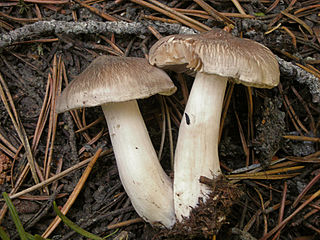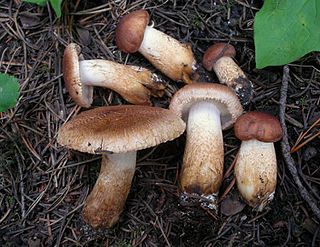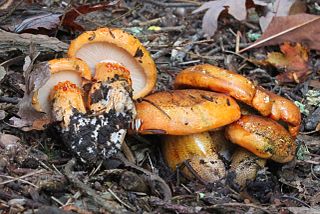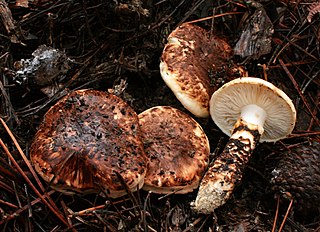
Matsutake, Tricholoma matsutake, is a species of choice edible mycorrhizal mushroom that grows in Eurasia and North America. It is prized in Japanese cuisine for its distinct spicy-aromatic odor.

Tricholoma is a genus of fungus that contains many fairly fleshy white-spored gilled mushrooms which are found worldwide generally growing in woodlands. These are ectomycorrhizal fungi, existing in a symbiotic relationship with various species of coniferous or broad-leaved trees. The generic name derives from Ancient Greek: τριχο-, romanized: tricho-, lit. 'hair' and Ancient Greek: λῶμα, romanized: loma, lit. 'fringe, border' although only a few species have shaggy caps which fit this description.

Tricholoma equestre or Tricholoma flavovirens, commonly known as the man on horseback or yellow knight is a widely eaten but arguably toxic fungus of the genus Tricholoma that forms ectomycorrhiza with pine trees.

Tricholoma magnivelare, commonly known as the matsutake, white matsutake, ponderosa mushroom, pine mushroom, or American matsutake, is a gilled mushroom found East of the Rocky Mountains in North America growing in coniferous woodland. These ectomycorrhizal fungi are typically edible species that exist in a symbiotic relationship with various species of pine, commonly jack pine. They belong to the genus Tricholoma, which includes the closely related East Asian songi or matsutake as well as the Western matsutake (T. murrillianum) and Meso-American matsutake (T. mesoamericanum).

Tricholoma pardinum, commonly known as spotted tricholoma, tiger tricholoma, tigertop, leopard knight, or dirty trich, is a gilled mushroom widely distributed across North America, Europe, and parts of Asia. It is generally found in beech woodland in summer and autumn. Two subspecies have been described from southern Europe. First officially described by Christiaan Hendrik Persoon in 1801, T. pardinum has had a confusing taxonomic history that extends over two centuries. In 1762, German naturalist Jacob Christian Schäffer described the species Agaricus tigrinus with an illustration corresponding to what is thought to be T. pardinum, and consequently, the name Tricholoma tigrinum has been used erroneously in some European field guides.

Tricholoma terreum, commonly known as the grey knight or dirty tricholoma, is a grey-capped mushroom of the large genus Tricholoma. It is found in coniferous woodlands in Europe, and has also been encountered under introduced pine trees in Australia and New Zealand. It is regarded as edible. A 2014 article speculated that it may be poisonous, but Sitta et al. in 2016 published in the same journal a counter article demonstrating the unfounded nature of such speculation.

Tricholoma saponaceum, also known as the soap-scented toadstool, soapy tricholoma, soapy knight or soap tricholoma is an inedible mushroom found in woodlands in Europe and North America.

Tricholoma columbetta, commonly known as dove-coloured tricholoma, is an edible mushroom of the large genus Tricholoma. It is found in Europe, where it is eaten in France.

Tricholoma portentosum, commonly known as the charbonnier, streaked tricholoma, or sooty head, in North America, is a grey-capped edible mushroom of the large genus Tricholoma. It is found in woodlands in Europe and North America.

Tricholoma virgatum, commonly known as the ashen knight, is a mushroom of the agaric genus Tricholoma. It was first described scientifically as Agaricus virgatus by Elias Fries in 1818, and later transferred to the genus Tricholoma by Paul Kummer in 1871. It is found in the deciduous and coniferous forests of Europe, North America, and China. The mushroom is inedible, speculated to be poisonous, and has a bitter and peppery taste and musty odor.

Tricholoma atrosquamosum, commonly known as dark-scaled knight, is an edible gilled mushroom native to Europe. The grey-capped fruit bodies are generally found singly or in small groups in deciduous woodland on chalk-based soils.

Tricholoma vaccinum, commonly known as the russet scaly tricholoma, the scaly knight, or the fuzztop, is a fungus of the agaric genus Tricholoma. It produces medium-sized fruit bodies (mushrooms) that have a distinctive hairy reddish-brown cap with a shaggy margin when young. The cap, which can reach a diameter of up to 6.5 cm (2.6 in) wide, breaks up into flattened scales in maturity. It has cream-buff to pinkish gills with brown spots. Its fibrous, hollow stipe is white above and reddish brown below, and measures 4 to 7.5 cm long. Although young fruit bodies have a partial veil, it does not leave a ring on the stipe.

Tricholoma ustale, commonly known as the burnt knight, is a species of mushroom in the large genus Tricholoma. It is found in Asia, Europe, and North America, though those from North America may represent one or more different species.

Tricholoma aurantium, commonly known as the golden orange tricholoma, is a mushroom of the agaric genus Tricholoma. Originally described by Jacob Christian Schäffer in 1774, it was transferred to the genus Tricholoma by Adalbert Ricken in 1915.

Tricholoma caligatum is a mushroom of the agaric genus Tricholoma. It is a large species with a distinct sheathing ring on the stem, found in mycorrhizal association with various trees throughout the Mediterranean. It is sometimes referred to as the European Matsutake, though it is certainly gastronomically inferior to the true Matsutake, a related species highly prized in Japan.

Tricholoma vernaticum is an agaric fungus of the genus Tricholoma native to the Pacific Northwest region of the United States. The fungus was originally described in 1976 as a species of Armillaria when that genus was more inclusive; it received its current name twenty years later. The stout fruit bodies (mushrooms) have moist white to grayish caps, a membranous ring on the stipe, and an odor resembling cucumbers. Mycorrhizal with conifers, the fungus fruits in the spring or early summer, with its mushrooms appearing on the ground singly or in groups at high elevations, often at the edge of melting snowbanks. The edibility of the mushroom is unknown, but it has a strong unpleasant odor and a mealy taste.

Floccularia albolanaripes is a species of fungus in the family Agaricaceae. Mushrooms are characterized by their yellow caps with a brownish center and scales over the margin, and the conspicuous remains of a partial veil that is left on the stipe. The species grows in the Pacific Northwest and the Rocky Mountains of North America, and in India.

Tricholoma populinum, commonly known as the poplar tricholoma, sandy, or cottonwood mushroom, is a mushroom of the agaric genus Tricholoma. It was formally described by Danish mycologist Jakob Emanuel Lange in 1933. It is traditionally eaten by the Salish Native Americans in British Columbia.


















